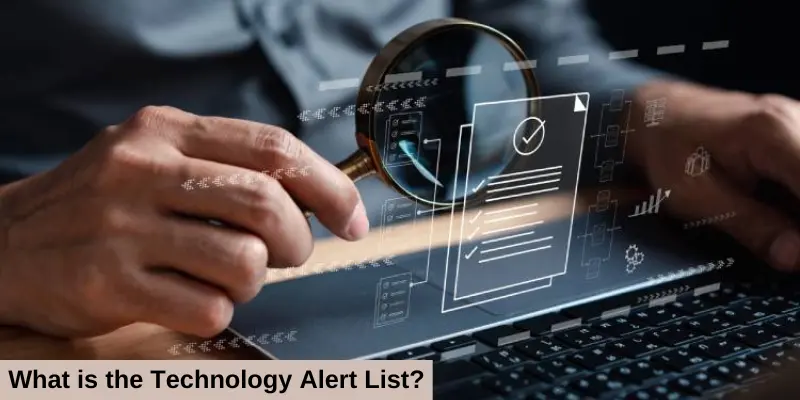Technology Alert List | Web Gege
Updated: 04 Apr 2025
Technology Alert List is an important tool used by the United States to protect its national security. It helps prevent the transfer of sensitive technologies that could be used in ways that harm the country or disrupt global peace. TAL includes a list of specific fields and subjects that are considered critical, such as nuclear technology, aerospace engineering, and artificial intelligence.
If someone from another country is applying for a U.S. visa and their work or studies involve these fields, their application might need extra security checks. This is to make sure the technology they access does not fall into the wrong hands or get used for harmful purposes.
The TAL plays a key role in balancing the benefits of international collaboration in science and technology with the need to protect the nation. While it helps enhance security, it has also sparked debates, especially within the academic and research communities, about its impact on global collaboration.
What is the Technology Alert List?
The Technology Alert List (TAL) is a list created by the U.S. government to monitor and control the transfer of certain sensitive technologies. It identifies specific areas of science and technology that could pose a threat to national security if misused.

The TAL focuses on fields like nuclear technology, advanced materials, robotics, artificial intelligence, and more. When someone from another country applies for a U.S. visa and plans to work, study, or research in one of these areas, their application might be reviewed more closely. This extra review helps ensure that sensitive information or technology is not shared in ways that could harm the U.S. or its allies.
In simple terms, the TAL acts like a protective shield. It allows the U.S. to welcome talented individuals from around the world while still safeguarding critical technologies. However, it is also a subject of debate, especially among researchers and educators, as it can sometimes create challenges for international collaboration in scientific and technological fields.
You May Also Visit This Link: Best Rosa Gadget
Historical Background of the Technology Alert List
The Technology Alert List (TAL) was created to address growing concerns about the transfer of sensitive technology to individuals or countries that could misuse it. Its origins date back to the late 20th century when the United States recognized the need to balance the benefits of global scientific collaboration with the risks of advanced technologies being used for harmful purposes.
The TAL became particularly significant after the tragic events of September 11, 2001. In response to heightened security concerns, the U.S. government tightened its policies to protect critical fields like nuclear technology, advanced materials, and aerospace engineering. This led to updates in the TAL, ensuring it covered emerging technologies that could impact national security.
Initially focused on traditional areas like weapons development and espionage, the TAL has evolved over the years to include modern fields like artificial intelligence and biotechnology. These additions reflect the rapid advancements in technology and their potential dual uses benefiting society or being used for harmful purposes.
Today, the TAL serves as a key tool in preventing unauthorized access to sensitive information while encouraging responsible innovation and global collaboration. Despite its important role, it has sparked debates about its impact on academic exchanges and international research partnerships.
You May Also Visit This Link: Rs 149 Bear Design Long-Sleeve Baby Jumpsuit Thespark Shop
Critical Fields Listed in the Technology Alert List
The Technology Alert List (TAL) highlights specific areas of science and technology that are considered sensitive because of their potential to impact national security. These fields often have dual use applications, meaning they can be used for both peaceful and harmful purposes. Here is an overview of the critical fields commonly listed under the TAL:
1. Nuclear Technology
Includes anything related to nuclear weapons, reactors, fuel processing, and power plants. This field is closely monitored to prevent the proliferation of nuclear weapons and technology.
2. Rocket Systems and Aerospace Engineering
Covers technologies used in missiles, rockets, and spacecraft. This ensures that advanced aerospace technology is not misused for weapons delivery systems.
3. Advanced Materials and Manufacturing Techniques
Focuses on materials like high strength alloys, composites, and manufacturing processes that can be used to create advanced weapons or military equipment.
4. Artificial Intelligence (AI)
Monitors developments in AI and machine learning, particularly those with applications in autonomous systems, surveillance, or cybersecurity.
5. Biotechnology
Includes genetic engineering, synthetic biology, and related fields that could be used to create biological weapons or modify organisms in dangerous ways.
6. Chemical Technology
Targets knowledge of chemicals and processes that could be used in making chemical weapons.
7. Telecommunications and Encryption
Monitors advanced communication systems and encryption methods, which could impact cybersecurity and national defence.
8. Robotics
Ensures that advanced robotics systems, particularly those with military or surveillance uses, are not shared without safeguards.
9. Nanotechnology
Addresses the manipulation of materials at the nanoscale, which has applications in both medicine and advanced weaponry.
10. Marine Technology
Focuses on systems related to underwater navigation, warfare, or remote sensing, such as submarines or sonar technologies.
11. Sensors and Radar Systems
Includes technologies used in advanced tracking, navigation, and targeting systems.
These fields are closely monitored by the U.S. government during visa applications for individuals in related professions. This helps ensure that sensitive information and technology do not fall into the wrong hands, while still allowing safe and beneficial international collaboration in these critical areas.
You May Also Visit This Link: Rs 125 Only on Thespark Shop Men Jackets
Recent Developments and Future Outlook of the Technology Alert List
The Technology Alert List (TAL) has been continuously updated to keep pace with the rapid advancements in science and technology. With emerging fields like artificial intelligence, biotechnology, and quantum computing gaining prominence.

The U.S. government has been expanding and refining the TAL to address these evolving challenges.
Recent Developments
1. Focus on Emerging Technologies
Recent updates to the TAL have placed greater emphasis on cutting edge fields like artificial intelligence, cybersecurity, and quantum computing. These technologies have immense potential for societal benefits but also pose significant security risks if misused.
2. Heightened Visa Scrutiny
In response to global security concerns, especially those linked to sensitive geopolitical issues, the process for visa applicants in TAL related fields has become stricter. This includes more in depth security checks and the increased use of Security Advisory Opinions (SAOs) for applicants.
3. Collaboration with Allies
The TAL is not just a domestic tool. The U.S. has been working closely with its allies to share best practices and create unified approaches to monitoring sensitive technologies on a global scale.
4. Adapting to Hybrid Threats
New technologies that combine different fields like AI driven robotics or bioinformatics have been added to the TAL to address potential hybrid threats that do not fit neatly into one category.
Future Outlook
1. Inclusion of Quantum and Space Technologies
With the growing importance of quantum computing and commercial space exploration, these fields are expected to receive greater attention. Policies may evolve to ensure their secure development and use.
2. Increased Global Collaboration
As science becomes more collaborative, there is a push to strike a better balance between protecting sensitive technologies and fostering international partnerships in research and innovation.
3. Stronger Ethical Frameworks
Future updates to the TAL might include ethical guidelines, ensuring that sensitive technologies are not only secured but also used responsibly in alignment with global values.
4. Improved Screening Mechanisms
The visa screening process for individuals in TAL related fields is likely to become faster and more efficient with the help of advanced AI and big data analytics, reducing delays while maintaining high security.
5. Periodic Revisions
The TAL will likely undergo more frequent revisions to keep up with the ever changing technology landscape, ensuring it remains relevant and effective in addressing emerging threats.
You May Also Visit This Link: The Spark Shop – Online Shopping Big Discount
Advantages and Disadvantages of the Technology Alert List
The Technology Alert List (TAL) plays a crucial role in ensuring national security by regulating the transfer of sensitive technologies. However, like any system, it has both advantages and disadvantages. Lets take a closer look at both sides.
| Pros |
|---|
|
| Cons |
|---|
|
Common FAQs about the Technology Alert List
Here are some frequently asked questions (FAQs) about the Technology Alert List (TAL) to help you understand it better.
The Technology Alert List (TAL) is a list of specific technology fields that the U.S. government monitors to protect national security. It includes areas like nuclear technology, robotics, and artificial intelligence, ensuring that sensitive technology does not fall into the wrong hands.
The TAL was created to prevent the spread of advanced technologies that could be used in harmful ways, such as building weapons or causing instability. It helps ensure that critical technologies are securely managed and not misused by individuals or countries with harmful intentions.
If someone applies for a visa to work or study in the U.S. in one of the fields listed on the TAL, their application may go through additional security checks. This is to ensure that sensitive technology isn’t being transferred or misused.
The TAL mainly affects people who work in sensitive areas like nuclear technology, aerospace engineering, biotechnology, or artificial intelligence. It impacts individuals seeking U.S. visas to study, research, or work in these fields.
The TAL covers various technologies that could be used for harmful purposes, including:
- Nuclear technology and weapons
- Rocket and missile systems
- Advanced materials and manufacturing techniques
- Artificial intelligence
- Biotechnology and genetics
The TAL does not completely block international collaboration, but it does add more steps and safeguards for sensitive areas. It ensures that global research partnerships are secure while preventing risky technology transfers.
If you are in a field listed on the TAL and plan to apply for a visa or work in the U.S., your application may require additional reviews or security checks. You may also need to provide more information about your work.
The TAL is updated regularly to keep up with emerging technologies and changing security concerns. As new fields of technology develop, they are sometimes added to the list to ensure they are monitored properly.
If an individuals work or studies fall under a TAL listed field, their visa application could be delayed or denied, especially if there are concerns about national security. However, not all cases result in denials; it depends on the specifics of the application.
No, the TAL mainly affects individuals from other countries who are applying for U.S. visas, especially those who want to work or study in the sensitive fields listed on the TAL. U.S. citizens are not directly impacted by the TAL for visa purposes.
Bonus Points on the Technology Alert List
Here are a few bonus points to help you better understand the Technology Alert List (TAL):
- It Helps Balance Security with Innovation: The TAL is all about striking a balance. On one side, it aims to protect sensitive technologies from being misused, but on the other side, it allows for safe international collaborations and encourages innovation. This way, global partnerships can thrive without compromising security.
- Encourages Ethical Use of Advanced Technologies: By keeping an eye on the critical fields in the TAL, the U.S. government promotes the responsible and ethical use of powerful technologies like artificial intelligence and biotechnology. This helps avoid the misuse of technologies that can be harmful to society.
- It Supports Diplomatic Cooperation: The TAL is not just about stopping the transfer of sensitive tech. It also encourages the U.S. to cooperate with other countries in managing sensitive research and ensuring the safe exchange of technological knowledge.
- Potential to Safeguard Future Technologies: As new fields like quantum computing and space exploration gain traction, the TAL adapts to include emerging areas. This helps the U.S. stay proactive and ahead of potential risks associated with technologies that have not fully matured yet.
- A Proactive Approach to Global Security: Instead of reacting to threats after they happen, the TAL focuses on preventing misuse from the start. It takes a proactive approach to securing sensitive technologies by carefully monitoring and controlling how they are shared across borders.
- Part of a Broader Security Framework: The TAL is just one part of a larger effort to secure technologies of national importance. It works in conjunction with export controls, trade regulations, and security policies to keep the most advanced and potentially dangerous technologies out of the wrong hands.
- Long Term Focus: By monitoring sensitive technologies, the TAL ensures that they are used responsibly for years to come. This long term approach means that technology advances in a way that benefits global security and does not unintentionally create new risks.
Conclusion
The Technology Alert List (TAL) plays a vital role in protecting national security by keeping track of sensitive technologies that have the potential to be used for harmful purposes. By carefully monitoring fields like nuclear technology, artificial intelligence, and biotechnology, the TAL helps ensure that these technologies don’t fall into the wrong hands.
While the TAL is primary goal is security, it also strives to strike a balance between innovation and safety. It allows for international collaborations and research while implementing safeguards to protect both global and national security.
However, the TAL also faces challenges. Some argue that it can slow down scientific progress and create barriers for researchers from different countries. Yet, its ability to prevent misuse of powerful technologies makes it an essential tool in today’s rapidly advancing technological landscape.
As technology continues to evolve, the TAL will likely adapt and expand to include new areas of concern, ensuring that the U.S. stays prepared to address potential threats while fostering safe and responsible global collaboration.
You May Also Visit This Link: Rs 125 Only on Thesparkshop.in Batman Style Wireless BT Earbuds





